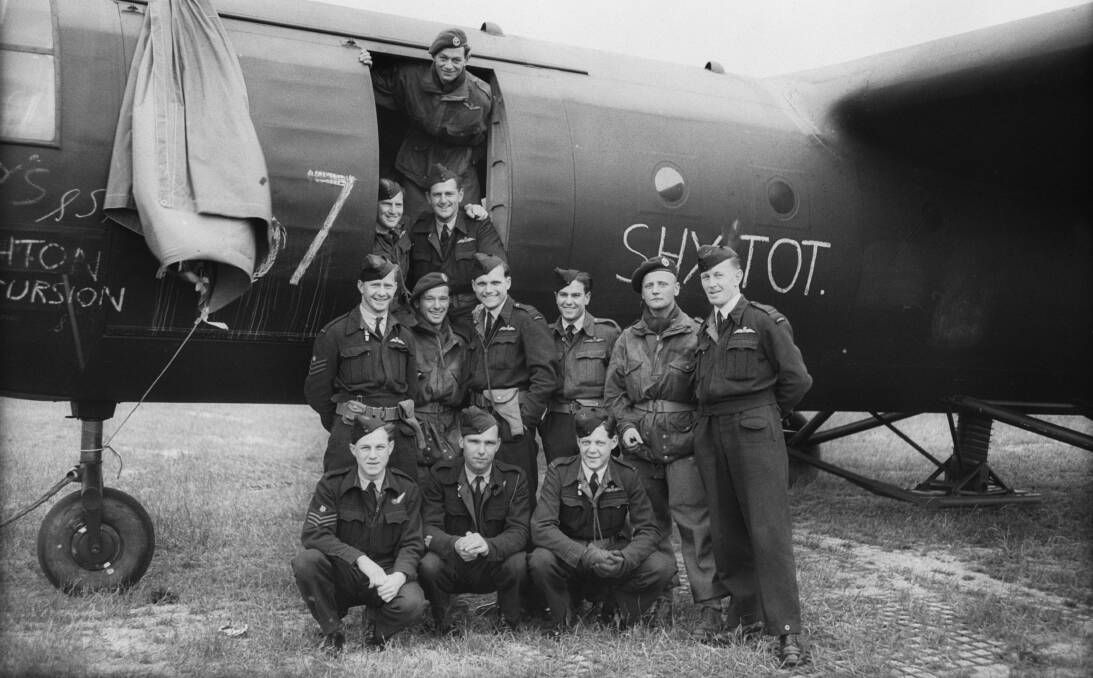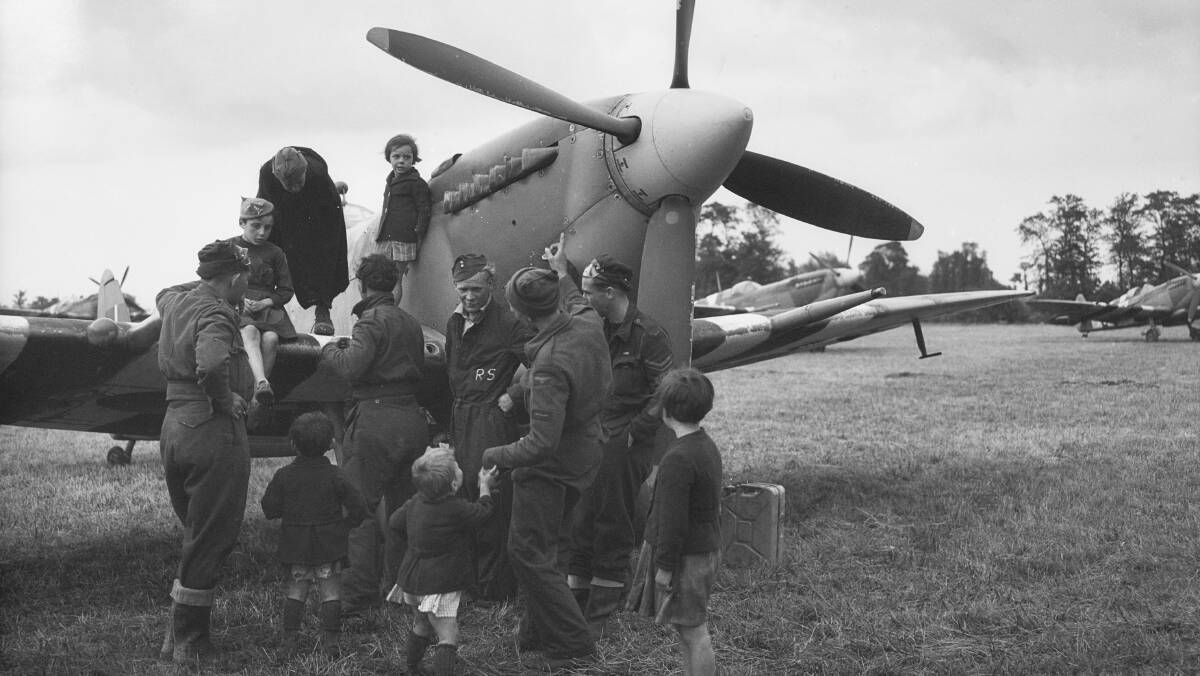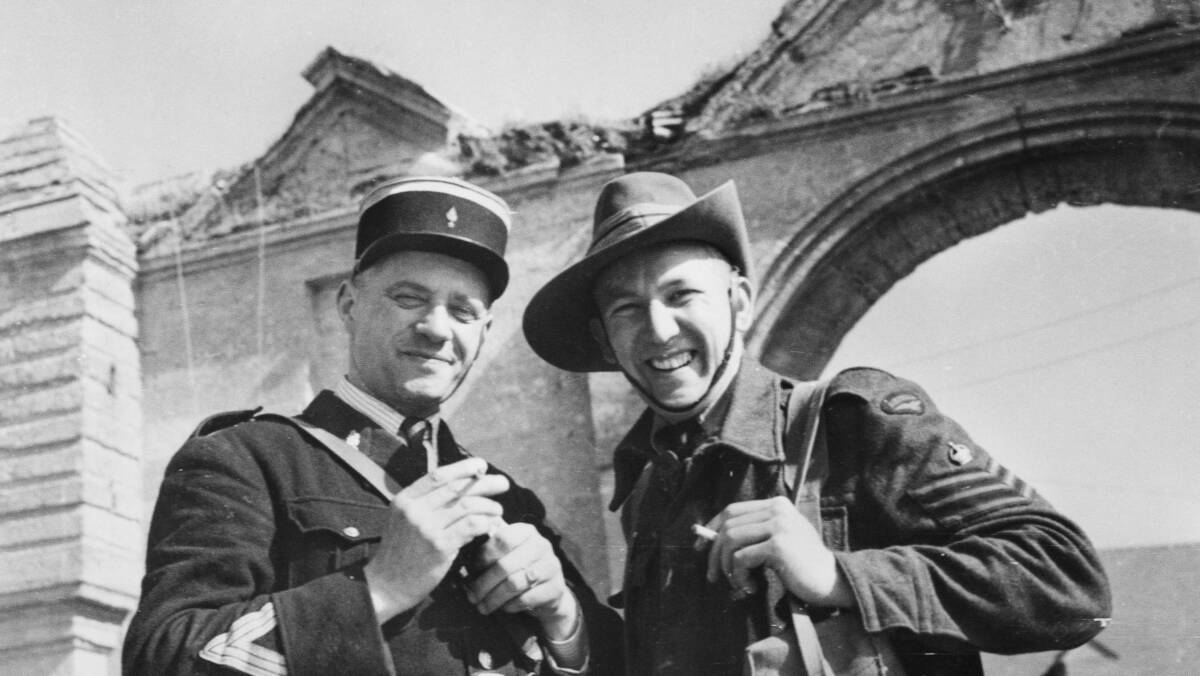Seventy-five years ago this week a 21-year-old Australian, Stanley Black, from the Melbourne suburb of North Fitzroy, was in the thick of it in the skies above the Normandy battlefield.
Subscribe now for unlimited access.
or signup to continue reading
On D-Day, June 6, 1944, British, American, and Canadian soldiers stormed ashore in France to begin the liberation of Western Europe from Nazi occupation. The following evening Flight Sergeant Black, one of seven members of a Lancaster bomber crew of No. 106 Squadron, Royal Air Force, was sent on a mission to help secure the Allied beachhead.
Black's Lancaster was shot down by enemy fire and he was forced to bail out. He parachuted to safety and joined a group of American paratroopers from the US 82nd Airborne Division who were holding the village of Graignes. A German SS division was approaching the village, and the Americans welcomed a friendly straggler ready to join their ranks. Outnumbered ten to one, the Americans held Graignes for a crucial 24 hours, preventing the German advance toward the Allied beachheads.
When the Germans finally entered Graignes on June 11 they rounded up and executed the remaining paratroopers, along with two local priests and 40 villagers. Flight Sergeant Black was among those killed in the battle. His name is listed on a memorial to those who died in the defence of Graignes.

His is a remarkable but little-known story; just one of the thousands of Australians who took part in the D-Day landings and the battle for Normandy.
D-Day, June 6, 1944, is one of the defining events of the Second World War. Many will be familiar with the horrific opening sequence of the film Saving Private Ryan (1999), or the HBO series Band of Brothers (2001). For younger generations, their introduction to what Winston Churchill described as "much the greatest thing ... ever attempted" may come from games such as Call of Duty or Medal of Honor. Such media mostly provides an American perspective, but more than a dozen nations - including Australia - were represented among the crews of some 6000 ships, 10,000 aircraft, and the British, American, and Canadian army groups that stormed the beaches.
In the West, the commemorations marking the anniversary of D-Day on June 6 have become the most internationally significant event remembering the Second World War. The war in Europe was not fought simply for balance-of-power politics; it was fought for ideals. This is why D-Day commemorations, and acknowledging Australia's participation in the war, are so important.
More than 3300 Australians were active in the D-Day landings.
Remembering the Australian volunteers who participated in the D-Day landings, even if they made up a very small portion of the overall British forces, matters for the simple reason that Australia - a small nation at the time - was a proactive participant in a coalition standing united against Hitler's murderous and criminal Nazi regime, one which rejected the most basic democratic and civil rights.
The stories of the Australian men and women who participated in the battle of Normandy are not well known, yet more than 3300 Australians were active in the D-Day landings (2800 airmen, 500 sailors, and small numbers of men and women in the British army), while thousands more served during the subsequent Normandy campaign. Thirteen Australians were killed on June 6, but the campaign lasted beyond that one day. On June 7, 20 Australian airmen were killed; on June 8 another 22 died, and these losses continued until August. In fact, more than 1100 Australians were killed in the war in Europe in the build-up to and during the Normandy battle (April-August 1944). To this day June 1944 remains the costliest month for casualties in the history of the Royal Australian Air Force.

Life was particularly dangerous for those pilots flying low-level operations to support the ground troops: of the 23 pilots with No. 453 Squadron, RAAF, at the start of the campaign, 20 were no longer with the squadron by the end of September. During this period 57 pilots served, and almost the entire squadron had been turned over, replacing pilots who had been killed, missing, wounded, captured, or were "operationally tired".
This rate of turnover was recalled by pilots of other squadrons, including Typhoon pilot Herbert Copeman from Brisbane, who joined No. 137 Squadron, RAF, in Normandy in July. After only a handful of sorties Copeman recalled, "I had seen so many mates shot down, that I realised I was going to die". Copeman did survive, flying all the way to VE Day on May 8, 1945, but when the squadrons of his wing were celebrating the Allied victory he looked around and realised "I was the only 'ex-Normandy' pilot present at the party and felt very strangely sad and lonely".
Part of the difficulties facing historians in recognising the Australian D-Day story is identifying the contributions of thousands of individuals who served attached to British squadrons and naval vessels. No Royal Australian Navy vessel was involved in the landings, but Australian sailors were spread across the British fleet. A small number of Australian officers commanded British destroyers, corvettes, minesweepers, landing craft, and torpedo boats.
In the air, 10 RAAF squadrons were involved and No. 453 Squadron operated from the ground in Normandy in the weeks after the landing. But the majority of Australian airmen were spread amongst more than 200 RAF squadrons.
In the past decade, with the digitisation of service records and contemporary newspapers by the National Archives of Australia and the National Library of Australia, it has been easier to discover and recover more and more of the diverse stories.
Other incredible tales of Australian participation in D-Day include that of Lieutenant Kenneth Hudspeth who commanded one of two midget submarines off the coast of France. These were the first craft to cross the English Channel as the vanguard to the invasion fleet. Hudspeth's submarine surfaced off the landing beaches to act as a beacon for the Allied armada. He was awarded his third Distinguished Service Cross for his efforts.
Another notable Australian was Sub-Lieutenant Richard Pirrie, who commanded a landing craft at Juno Beach. Pirrie gave up a promising VFL football career with the Hawthorn Football Club when he enlisted in the RAN. On June 6, 1944, his 24th birthday, Pirrie was with the first wave of landing craft. Tasked with the dangerous job of piloting close to the beach so that a naval artillery observer could direct gunfire onto German defences, Pirrie was killed when his craft struck a mine and was simultaneously hit by enemy fire. For his gallantry, leadership, and determination on D-Day, Pirrie was posthumously Mentioned in Dispatches.

Also at Juno Beach was Lieutenant Commander George Dixon from Tasmania. Dixon was an original Anzac, having landed on Gallipoli on April 25, 1915 as an underage infantryman (having enlisted when he was 15) and was later severely wounded. He enlisted in the navy after the outbreak of the Second World War and before commanding Landing Ship Tank 409 on D-Day he had commanded landing craft during the 1943 landings at Sicily and Italy.
One of the emerging stories of a small handful of Australian women - mostly nurses - known to have landed in Normandy with the British Army is the remarkable tale of Olive Sherington from Sydney, who served as a Senior Commandant in the Mechanised Transport Corps. Sherington was holidaying in Britain when war broke out in 1939. She enlisted and served in the battle of France in 1940, driving an ambulance, and was one of the last British women to leave France after the evacuation of Dunkirk. She was also one of the first women with the British forces to return to France, driving her truck off a landing craft onto the beaches days after the invasion.
For her service, Sherington was Mentioned in Dispatches and received a commendation for bravery from King George VI and Winston Churchill. Other Australian women in Normandy include Sister Nancy Kinsella and Sister Ann Swinton, who served with the Queen Alexandra Nursing Service, Sister Heather Kirkwood, who served with the Territorial Army Nursing Service, and Anne Matheson, who was war correspondent for The Australian Women's Weekly.
Black, Hudspeth, Pirrie, Dixon, and Sherington are just a few of the one million Australians who served in the Second World War. By honouring the brave efforts of our Normandy veterans we pay tribute to the nation's role in the wider global struggle to defeat not only Japanese militarism in our own region of Asia and the Pacific, but the evils of Nazism and fascism in Europe.
On the 75th anniversary of D-Day, we will remember them.
- Dr Lachlan Grant is a senior historian at the Australian War Memorial. The exhibition D-Day: the Australian story, is currently on display at the memorial until September 15, 2019.

